Modern football has been around for more than 150 years and still remains one of the most popular sports worldwide. Europe and football have a very close connection. The game is engraved in the soul of every European and is sometimes rightfully referred to as “The unofficial religion of Europe.” Football stadiums have a strong connection with the people.
In fact, you can’t actually be wrong in believing and saying so, because football is more than just a game here. Every street and city has football fanatics with zealous and spirited hearts waiting to see their favourite stars in action.
Due to such massive support and following, it is not a surprise that there are many stadiums and fields in almost every city of Europe. Some boast structural wonders in the array of stadiums, while some are famed for hosting unforgettable football moments, and then some give you the best of both. The strong memories held like wax and wane, glee and sorrow still smell fresh in our memories.
Let us dive into some of the most famous, heart touching, beautiful structures we call football stadiums in the land of palaces and castles – Europe.
Table of Contents
- 1. Camp Nou, Spain
- 2. Wembley Stadium, London
- 3. Croke Park, Dublin
- 4. Signal Iduna Park, Dortmund
- 5. Santiago Bernabéu Stadium
- 6. Stade de France, Paris
- 7. Luzhniki Stadium, Moscow
- 8. San Siro, Milan
- 9. Atatürk Olympic Stadium, Istanbul
- 10. Old Trafford, Manchester
- 11. Allianz Arena, Munich
- 12. Athens Olympic Stadium
- 13. Millennium Stadium, Cardiff
- 14. Stadio Olimpico, Rome
- 15. Olympiastadion, Berlin
- 16. Wanda Metropolitano, Madrid
- 17. Stade Vélodrom, Marseille
- 18. Murrayfield Stadium, Edinburgh
- 19. Estadio da Luz, Lisbon
- 20. National Arena, Bucharest
- 21. Stadion Feijenoord, Rotterdam
- 22. Parken Stadium, Copenhagen
- UEFA 2020 with Talk Home – Football Stadiums
1. Camp Nou, Spain
Stadium Capacity: 99,354
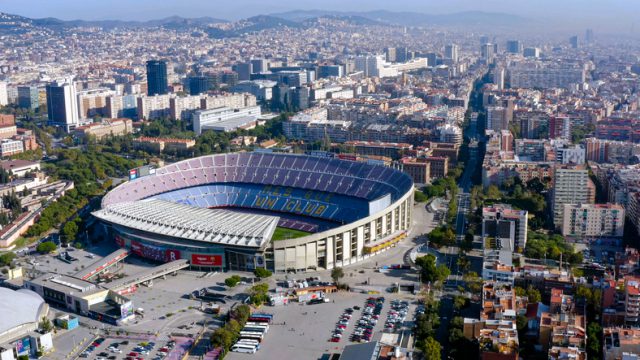
Camp Nou, the home ground of the Catalan champions FC Barcelona, is more than a stadium. Since its inception in the 1950s, it’s been a proud symbol of Catalonian culture and football supremacy. It is among the biggest football stadiums globally and the largest in Europe with a capacity of 99,354 seats with plans to reach 100,000 seats with state-of-the-art modifications, reflecting the team’s reputation.
The gigantic stadium brings back the time of the Roman Empire and the impression of the majestic gladiatorial arenas. Since 1957, the arena has hosted home games of FC Barcelona, and since 1992, the stadium serves as the base for the Catalonian national team. It has hosted two Champions League finals and the 1998/99 season Champions League final, the one where Manchester United splendidly defeated Bayern.
Spain hosted the 1982 FIFA World Cup, and undoubtedly, Camp Nou was the venue for one of the semi-finals. In the same year, 121,000 people joined the mass congregation here in the presence of the Pope for a Mass.
2. Wembley Stadium, London
Stadium Capacity: 90,000
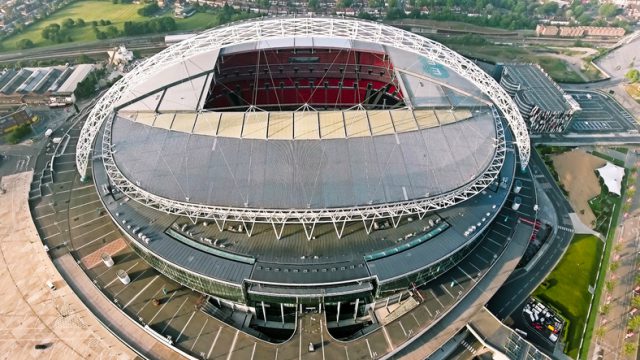
Wembley Stadium is the ultimate destination every English club wants to reach and is one of the most famous football stadiums in the world. The second-largest stadium in Europe, following the Camp Nou, is the conventional playing arena of the English national team. And an ultimate perfection of English football stadiums.
The stadium was rebuilt on the designs of HOK Sport and Fosters & Partners, opened to the public in 2007 with a total capacity of 90,000 people. The smart building has a retractable rooftop and the well-known Wembley Arch. While some might say the new structure doesn’t have the charm, it certainly has an electric atmosphere.
Wembley is the home of the English National team and hosts all the major domestic club competitions. The FA Cup final, the League Cup final and the FAA Community Shield are held at Wembley. In addition, two UEFA Champions League finals have been hosted here, in 2011 and 2013. Now the Euro 2020 cup final is also scheduled to be held here.
Similarly, the NFL International Series and many music concerts have also been held at the massive venue. Wembley has an enticing history, modern look, and facilities that make it the best stadium in the world.
Interesting Read: Get the Best of Europe – Your Ultimate Travel Guide
3. Croke Park, Dublin
Stadium Capacity: 82,300
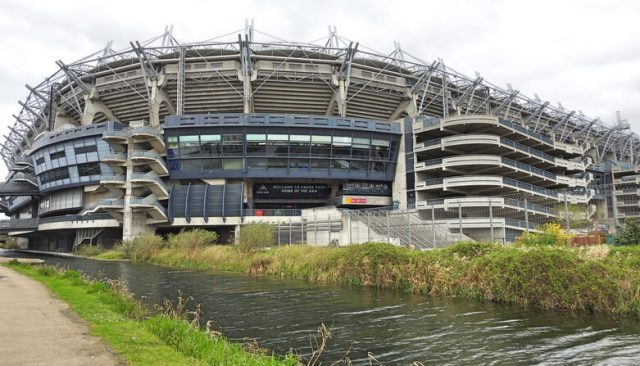
The iconic Croke Park stadium is named after the infamous Archbishop Thomas Croke of Ireland. This stadium serves as a national stadium for Ireland and the Gaelic Athletic Association (GAA) headquarters. Since 1891, GAA has hosted Gaelic sports, including the annual All0Ireland in Gaelic football and hurling sports event.
Other momentous events held at the stadium include the closing and opening ceremony of the 2003 special Olympics. Numerous musical concerts have also been held at this stadium. The primary developmental work of the stadium was held between 1991 and 2005. Over these years, the capacity of Croke Park Stadium has been raised to over 82,300 spectators.
The stadium also symbolises what can be achieved if a cohesive volunteer force works together for a unified goal. The matchday at Croke Park represents the commitment, challenging work, and dedication of over 2,200 clubs from all the 32 counties of Ireland. The atmosphere and colours engulfing the stadium during live matches display the skills and athleticism of the players on the pitch.
This stadium is utilised for events, from field sports to concerts and bespoke banqueting. The Croke park stadium actively offers guests and match patrons unrivalled facilities to enhance their experience.
4. Signal Iduna Park, Dortmund
Stadium Capacity: 81,365
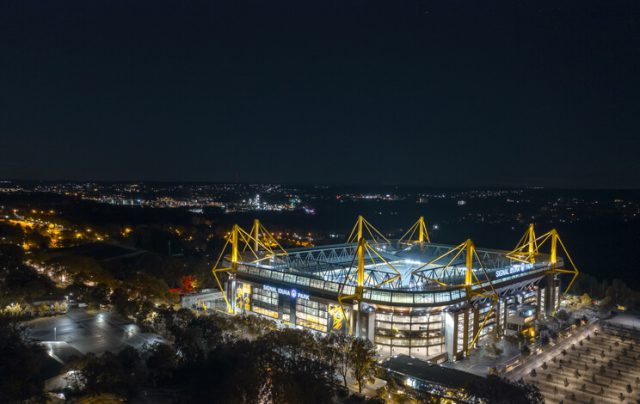
The largest stadium in Germany, Signal Iduna Park, hosts over eighty-one thousand fans and provides the best entertainment to football fans across Germany. This is one of the largest and most comfortable stadiums across Europe. Over millions of dollars are spent by Borussia Dortmund in Dortmund to renovate the stadium and keep the pitch clean.
The scene found on Strobelalle – known as “The Temple” by fans and routinely named “The excellent stadium within the country” by the press, experts, and VIPS alike is the biggest stadium. The stadium was redesigned for the run-up of FIFA 2016. However, certain works are carried out on the stadium each year, with BVB contributing millions of Euros to redesign the field.
For the reconstruction work, both the south stand was reinforced through measures, and concrete sanitation measures were executed within the northern portion of the stadium. Seven new modern boxes were made while an impressive digital technology providing enhanced security was introduced. Moreover, new scoreboards were also installed to give the stadium an all-out latest look.
5. Santiago Bernabéu Stadium
Stadium Capacity: 81,044
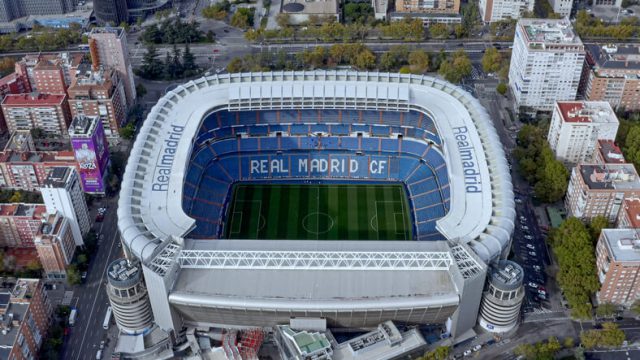
The second-largest stadium in Spain, Santiago Bernabéu, is home to football fans in Spain. The stadium was completed in 1947, and since then, the stadium has hosted multiple football matches and provided endless entertainment to football lovers across Europe.
Santiago Bernabéu is named after the former footballer and Real Madrid President Santiago Bernabéu, the greatest footballer of his time. Over these years, the stadium has hosted the UEFA Champions League on four occasions. Moreover, the final match of the European Nations Cup in 1964 and FIFA World Cup 1abck in 1982 were also held at the same stadium.
Currently, a renovation project is in progress, which will increase the stadium’s capacity by 4000. Furthermore, the stadium’s height will also increase, and a new retractable roof will be added. Roman techniques will be utilised so that the stadium’s operation is not affected. By lifting the roof like the Romans, they will bring innovation to the stadium.
With this innovation, they intend to introduce more restaurants, a shopping centre, and a hotel with a view of the pitch. Moreover, the renovation teams aim to make it a digital stadium equipped with a 360-degree view of the whole stadium.
6. Stade de France, Paris
Stadium Capacity: 81,000
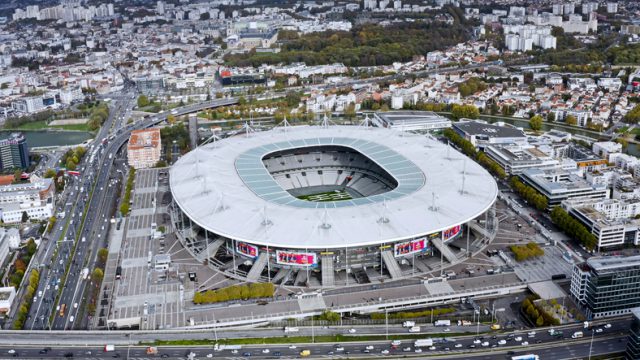
The home ground of the French National team since 1998, Stade de France is the stadium where France defeated Brazil in the 1998 FIFA World Cup Final. The pride of the french people, it has hosted many Champions League finals and Euro 2016. It is the seventh-largest stadium with a capacity of 81,000 people.
Similarly, the largest stadium in Europe for track and field events, housing 78,338 people in that configuration. The venue will host the opening and closing ceremonies of the 2024 Summer Olympics and matches of the 2023 Rugby World Cup.
UEFA has listed the stadium as Category 4 and hosted the UEFA Champions League finals in 2000 and 2006, also the 1999 and 1007 Rugby World Cup. That makes Stade de France one of the only two stadiums globally that have hosted both a football world cup final and the rugby union world cup final.
7. Luzhniki Stadium, Moscow
Stadium Capacity: 81,000
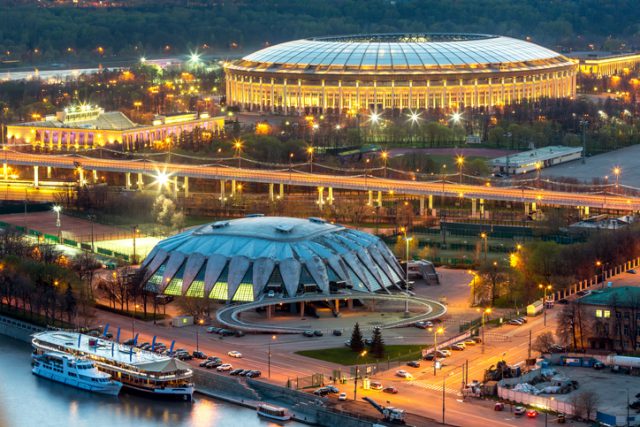
The Luzhniki Stadium, formerly known as the Lenin Stadium, is the national stadium of Russia. Built between 1955 and 1956, this stadium was a dire result of the ambitions of the Soviet leadership to upgrade the sports facilities of the country. Over these years, the stadium has served as a centrepiece for the Olympics and has also hosted the opening and closing ceremony of the game.
In 1999, Luzhunki Stadium hosted the UEFA Cup final held between Parma and Marseille. Moreover, the final of the Champions League between Manchester United and Chelsea was also held in the same stadium.
With Luzhunki Stadium having a history of hosting certain iconic matches in the history of football, there are no clubs associated with the stadium. This stadium is used as a home stadium for the Russian national football team. From time to time, the stadium has also been used for various other supports and concerts. It has also been used to host the finals of the Russian domestic cup.
This stadium has exclusive observations areas to help people with disabilities enjoy their favourite sports of the season. Moreover, after renovation, the stadium was also equipped with special extra-wide seats for plus-citizens. In short, this stadium has been crafted to meet all your needs.
8. San Siro, Milan
Stadium Capacity: 80,000
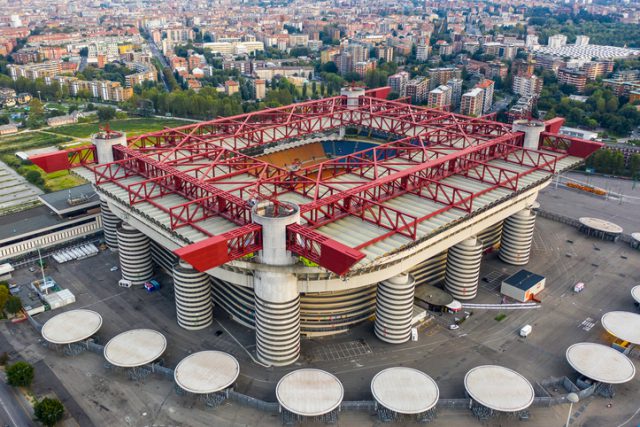
San Siro or the Stadio Giuseppe Meazza, is shared by two teams’ fans: AC Milan and Inter Milan. And it is among the most famous stadiums in Europe with its unique structure. The stadium was built in 1926 and opened with an inauguration match between Inter and AC Milan. It was packed with 35,000 spectators where Inter defeated AC Milan 6-3. And twice every year, the long rivalry is played out in the Derby Della Madonnina.
San Siro is the pride of Italy and a must-visit destination for football fans around the world. The stadium has a massive capacity of 81,000 people even though it was developed in 1926. The stadium was mainly designed for football and didn’t have the general athletics track around the perimeter found in most Italian stadiums.
San Siro has hosted four European Cup finals, including the 1934 FIFA World Cup, 1990 FIFA World Cup, the UEFA Euro Cup 1980, and the 2021 UEFA Nations League finals.
9. Atatürk Olympic Stadium, Istanbul
Stadium Capacity: 76,092
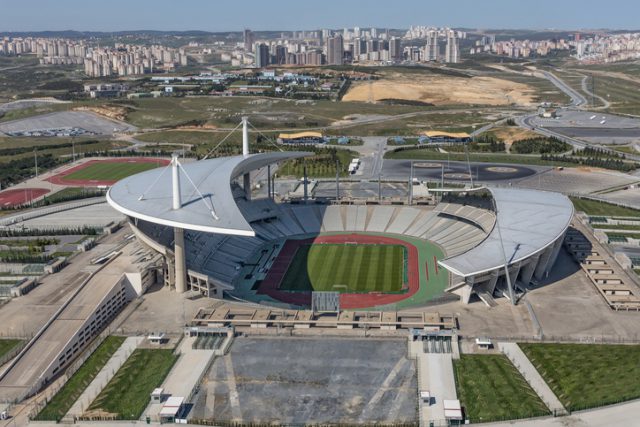
Located in the heart of Turkey, Atatürk Olympic is the largest stadium in the country. This stadium is named after the first President of the Republic of Turkey – Mustafa Kemal Ataturk. The stadium’s construction started in the year 1999, and it was completed in 2002. The foremost reason behind the construction of this stadium was the 2008 Olympic games that were awarded to Beijing, China.
The stadium gained the title of ‘5-Star Sports Complex’ by UEFA events. The iconic finals of the UEFA champions league between Milan and Liverpool were played at Ataturk Olympic stadium in 2005. The stadium was also set to stage the second finals of the Champions League, but the match was postponed due to restrictions due to the Covid-19 pandemic.
The stadium has been used by the Super League football team as their home stadium. Moreover, Sivasspor and Besiktas played their few home games at the Ataturk Olympic stadium. During the 2003-2004 season, Galatasary played their home matches at the stadium due to construction works performed at their own Ali Sami Yen stadium. This symbolises that the stadium has been used often by other teams across Turkey.
The Ataturk Olympic Stadium is in the centre of Istanbul within a semi-urban area alongside the motorway. There aren’t many restaurants around this area. Therefore, it is suggested that you do your eating and drinking within the city of Istanbul.
10. Old Trafford, Manchester
Stadium Capacity: 76,000
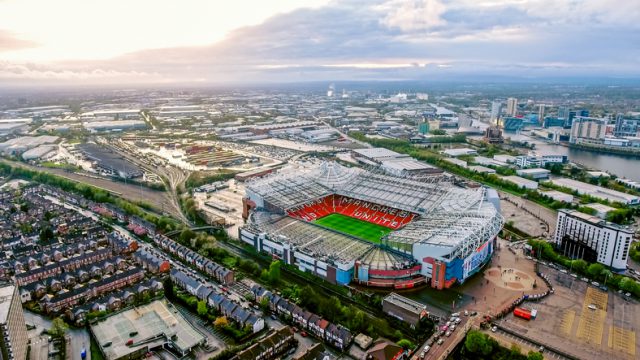
The Home of Manchester United, nicknamed the “Theatre of Dreams” by Sir Bobby Charlton, was built in 1909. The all enclosed stadium could seat 44,000 people back then, which was increased in 2007 to 76,000 seats. That made it the second biggest stadium in England after the Wembley stadium and the biggest club stadium in Great Britain.
The iconic ground has hosted legendary players like Sir Body Charlton, George Best, Eric Cantona, David Beckham, and Cristiano Ronaldo, who made history with their games.
For many people worldwide, visiting Old Trafford would be a dream come true. It symbolises the beginning of sporting events in the continent, landmarked with the first European game played against none other than the legendary Real Madrid in April 1957.
Old Trafford is among the most iconic football stadiums around the globe. After developing the modern structure of the post-Taylor era, the stadium joined top European avenues. It hosted the 2003 Champions League final, 2012 Olympic Football, 2021 Rugby League World Cup, and UEFA Women’s Euro 2021. The Red Devils supporters have many epic tales of the battles fought at their home ground through the years.
11. Allianz Arena, Munich
Stadium Capacity: 75,000
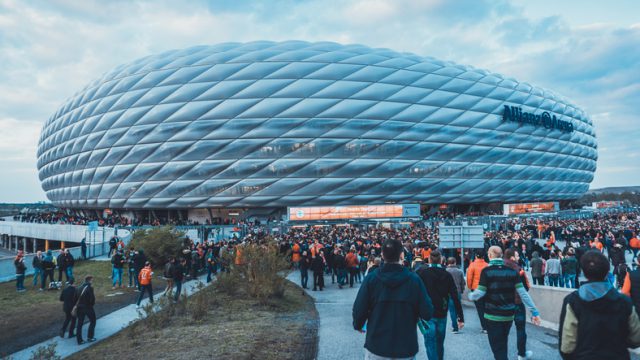
Allianz Arena is an architectural wonder and the most iconic stadium of the 21st century, featuring a beacon shape. The beautiful stadium, nicknamed Schlauchboot, “dinghy”, is covered in inflatable plastic bubbles. The bubble-shaped panels adorn the sides and make it a striking sight when the colour changes, which can be ideal for hosting different football teams and colouring according to each team.
The first stadium in the world with full colour changing the exterior is a marvel in itself. The German champion’s hometown stadium was opened in 2005 with a seating capacity of 70,000 for international matches and 75,000 for domestic games.
Primarily Bayern Munich uses the arena, but 1860 Munich also plays here. The name of the stadium changes every time FIFA and UEFA events happen here due to the policies forbidding corporate sponsorship. The stadium was referred to as FIFA World Cup Stadium, Munich during the 2006 FIFA World Cup and Football Arena Munich during the UEFA club and Nations League match.
The stadium hosted the 2012 UEFA Champions League final and will host the upcoming 2023 final. During the UEFA Euro 2020, the stadium will host three groups and one quarter-final match.
12. Athens Olympic Stadium
Stadium Capacity: 75,000
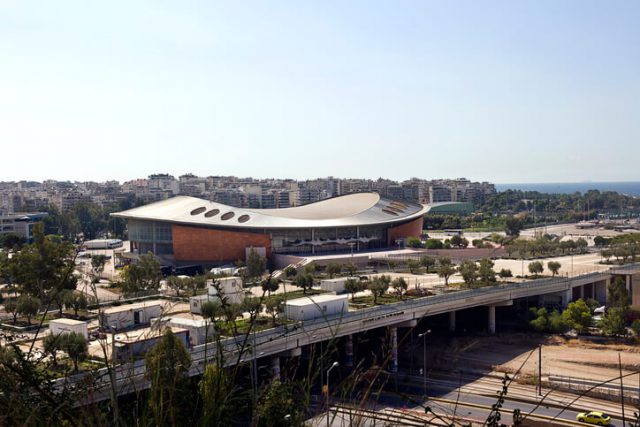
An essential venue for various sports events in Greece is the Athens Olympic stadium. The stadium is a host to one of the biggest sports clubs in the region. The stadium’s foundation was laid on 7 January 1980, and the stadium was opened in 1982. A year after the stadium’s completion, many sporting and cultural events have been held at this stadium.
The stadium was made through a revolutionary construction and involved a prefabricated method. Moreover, the stadium’s capacity is almost 70,000 guests and has become a venue of major sports events. This stadium also organised many guided tours and has a small museum that houses the Olympic torches. Even if you cannot watch a match an event in this stadium, you can always visit the site as a part of a guided tour and explore history.
The stadium is named after the first modern Olympic marathon gold medalist Spyros Louis. The stadium has served as the main stadium during the 2004 Summer Olympics. The stadium was renovated and innovatively positioned with Enerpac hydraulics for this event. In 2007, the 2007 UEFA Champions League final between AC Milan and Liverpool was also hosted in the same stadium.
13. Millennium Stadium, Cardiff
Stadium Capacity: 74,500
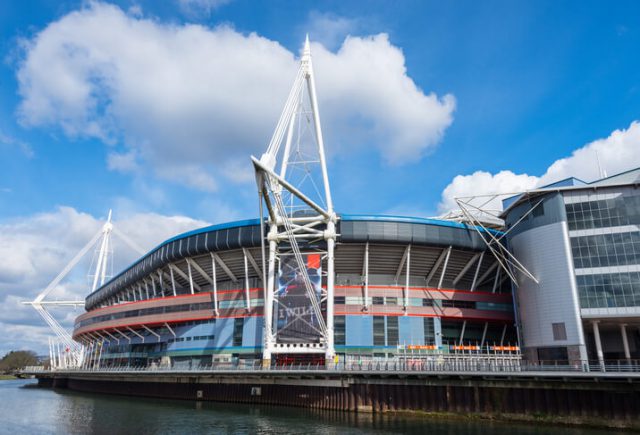
The Millennium Stadium is a highly acclaimed stadium based in Wales, also known as a Principality Stadium. This stadium is the Home of the National Rugby union team and has also held national football matches. Initially, the stadium was built to hold the Rugby World Cup 1999, but it has also been used to host social events such as the Tsunami Relief Cardiff.
Between 2001 and 2006, the stadium hosted the FA Cup, Football League play-off, and league cup. Moreover, the football matches of the Summer Olympics in 2012 were also held in the same stadium. Currently, the stadium is owned by the Millenium Stadium Subsidiary company of the Welsh Rugby Union (WRU). The stadium’s inauguration was held on 26 June 1999, and the first major event held there was a Rugby match between Wales and South Africa.
Millennium Stadium is the largest stadium in Wales and the fourth largest in the United Kingdom. In terms of the stadium with a fully retractable roof, this stadium is the second-largest stadium in the world. The stadium has been listed in the category four stadium by UEFA and was also chosen for the 2017 UEFA Champions League final. When the Welsh Rugby Union announced a 10-year sponsorship deal with the Principality Building Society, the stadium was renamed a “Principality Stadium”.
14. Stadio Olimpico, Rome
Stadium Capacity: 72,698
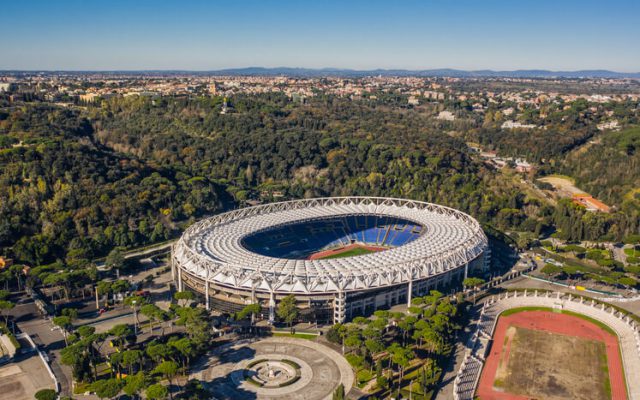
With a seating capacity of seventy thousand, Stadio Olimpico is the largest sports facility in Rome, Italy. The stadium is located within the Foro Italico sports complex, while the National Olympic Committee owns the building. The stadium is exclusively used for football and is a home stadium of the Roma and Lazio football clubs.
The stadium was rebuilt for the 1990 FIFA World Cup, and the final of the tournament was also hosted there. The stadium is also dedicated to sports, musical concerts, and other Olympic events.
Over the years, the stadium has undergone several renovations. The major restyling of the stadium began in 2007, and a major plan to restyle the design was laid down to conform to the UEFA standards. This work was completed in 2008, and it established a standard structure with improvements in security and dressing rooms. Contemporarily, the stadium has a current capacity of over seventy thousand persons.
15. Olympiastadion, Berlin
Stadium Capacity: 69,250
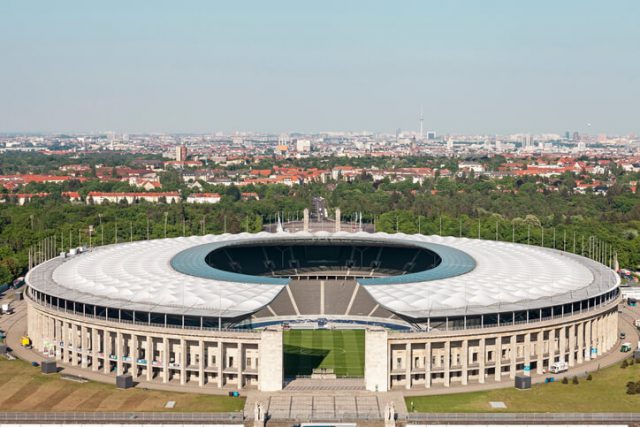
A famous stadium in Germany is the Olympia stadium which was initially built for the 1936 Summer Olympics. This stadium is a part of Olympia Park Berlin and has a capacity of over seventy-four thousand seats. This sitting capacity makes this stadium the largest Stadium in Germany for International football matches.
The Olympiastadion is a part of category four of UEFA and is one of the world’s most prestigious venues for sporting and entertainment events. Besides being famous for Athletics, the arena has built a football tradition and has been a home of Hertha BSX since 1963. The stadium has the honour of hosting three matches of the 1974 FIFA World Cup. Moreover, each year, the DFB Pokal final match is also held at the same venue.
The stadium has also served as a host for the 2011 FIFA Women’s World Cup and the 2015 UEFA Champions League final. The stadium was also used in 1936 to annually celebrate the King’s or Queen’s official birthday celebrations. Furthermore, in 2011, the venue hosted the World Culture Festival organised by Art of living, where more than seventy thousand people mediated for peace. In short, this is not just a football stadium but also holds a major significance for the history of Germany.
16. Wanda Metropolitano, Madrid
Stadium Capacity: 67,829

Termed as one of the most modern stadiums globally, Wanda Metropolitano is a home ground for Atletico De Madrid and can host around sixty-eight thousand people. The stadium is well connected by metro to the city centre and holds large-scale concerts. There is a fascinating museum in the stadium too which is open to the public.
The stadium was inaugurated in September 2017 near Adolfo-Suarez Madrid Barajas Airport. In 2019, the Champions League Final between Liverpool and Tottenham Hotspur was hosted. This new stadium has also become a venue for large-scale concerts, including Bruno Mars, Iron Maiden, and Ed Sheeran.
There is also an Atleti territory where the visitors can delve into the club’s history and its values. With the help of leisure and entertainment activities, an immersive experience is provided to the audience.
The match ticket in this stadium can be purchased either online or at the ticket office in Wanda Metropolitano commercial street. Online purchase of the tickets will have an exclusive reduced price.
17. Stade Vélodrom, Marseille
Stadium Capacity: 67,394
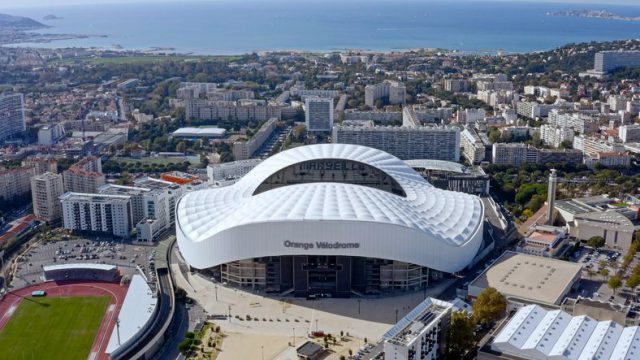
Stade Velodrome is a multi-purpose stadium in Marseille, France, and the Olympique de Marseille football club is home ground. The stadium’s inauguration was held in 1937, and it was also selected as a venue for the FIFA World Cups in 1938 and 1998. Furthermore, in 1960, 1984, and 2016, UEFA European Championships were also held in the same stadium.
The Stade Velodrome is the largest stadium in France. With a capacity of over sixty-seven thousand, the stadium is extensively used by the national rugby union team of France. RC Toulon rugby clubs also host their matches on the same field.
The undulating fibreglass roof of Marseille’s football stadium has been designed by the French SCAU, and they have also helped in extending the stadium’s capacity. Moreover, its figure has been beautifully designed to protect the structure from harsh weather. Although the original structure was designed by French Architect in the 1930s, SCAU renovated it in the 2000s and extended its sitting capacity. The stadium is four kilometres from the Old Port of Marseille.
18. Murrayfield Stadium, Edinburgh
Stadium Capacity: 67,144
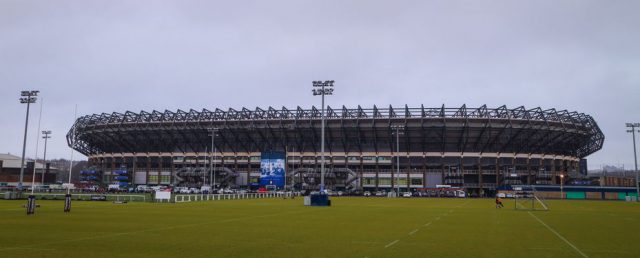
A popular name of the Murrayfield Stadium is Murrayfield. It is in the Murrayfield area of Edinburgh, Scotland. It has a seating capacity of over sixty-seven thousand people, making it the largest stadium in Scotland and the fifth largest in the United Kingdom.
The stadium is the Home of the Scottish Rugby Union and is used as a venue for Rugby Union. Although the stadium is primarily for rugby, it has hosted the American football rugby league and association football matches. Numerous musical concerts are also held in this stadium, apart from these sports events.
Murrayfield stadium also holds historical significance. During World War 2, the ground of Murrayfield was offered to the nation and was used as a supply depot. During the war, armed forces managed to arrange two matches each year. The historical attendance of the stadium was witnessed during the Five Nations Championship when Scotland defeated Wales.
Murrayfield is located next to Murrayfield Ice Rink and is close to Edinburg Zoo. Tourists worldwide visit this iconic stadium and get glimpses of their favourite matches each year.
19. Estadio da Luz, Lisbon
Stadium Capacity: 64,642
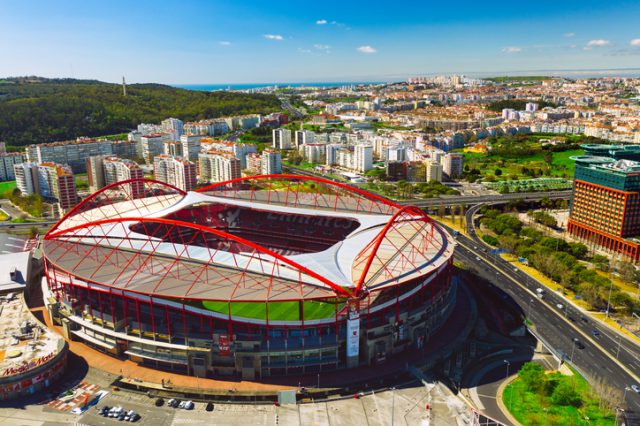
Officially named the Estádio to do Sport Lisboa e Benfica, it is the largest stadium in Portugal that was first opened in 1954 with 120,000 people. But later in 2003, it was rebuilt and opened with an exhibition match between Benfica and Nacional, an Uruguayan club. Designed by HOK Sport, the stadium’s seating capacity was reduced to 64,642 but still remains the biggest in Portugal.
It is one of the biggest stadiums in Europe by capacity and falls in the UEFA category four stadium, which means it can host games in the playoffs of the qualifying stage or any main competitions. The venue also hosted three group matches during the Euro 2004 Championships and the quarter-final between Portugal and England, the final between Greece and Portugal, and the 2014 Champions League Final between Real Madrid and Atletico Madrid.
The current home ground of S.L. Benfica was chosen to be the most beautiful stadium in Europe by L’Equipe, a French newspaper.
20. National Arena, Bucharest
Stadium Capacity: 55,634
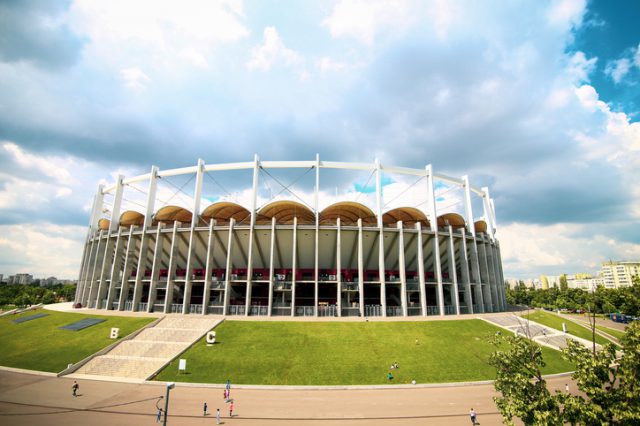
Arena Nationala, generally known as the National Arena of Romania, is a retractable roof stadium built on the site of the previous national stadium. It was officially opened in 2011 with the Euro-qualifier match between Romania and France. Since then, FC Steaua has used the stadium for high-profile league matches, and since 2015, all their home games have been played at the stadium. In contrast, from the start of the 2012/13 season, Dinamo has been playing their home league games at the stadium.
With a seating capacity of 55,634 people, it is the largest stadium in Romania, with a retractable roof that covers the playing surface. Arena Nationala is a UEFA category four stadium and has hosted the 2012 UEFA Europa League final that brought 52,347 people to the stadium. The stadium reached the highest audience at the 2014 FIFA World Cup qualifying match between Romania and Netherlands, bringing 53,329 spectators.
It is the home ground of the Romanian national team and hosted the 2012 Europa League final between Atletico Madrid and Club Athletic. Keeping its great legacy, the stadium will host three group matches of the UEFA Euro 2020.
21. Stadion Feijenoord, Rotterdam
Stadium Capacity: 51,117
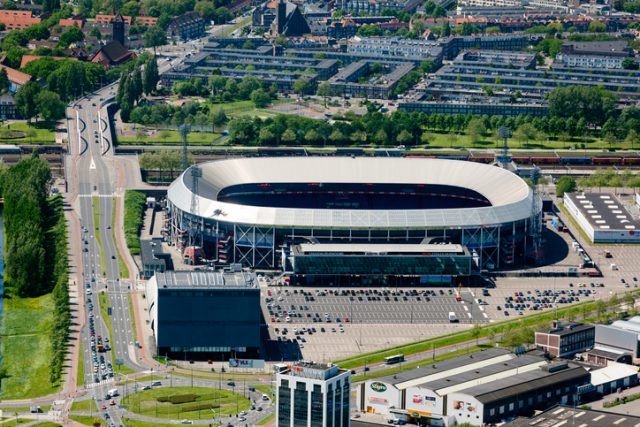
The Dutch Stadion Feijenoord, better known as De Kuip, ‘the Tub’ takes its name from the local neighbourhood and the team. The stadium was first built in the 1930s to give Feyenoord a home ground and a world-class stadium. The stadium’s original capacity was 64,000, which was increased to 69,000 and then converted to all-seater 51,117 seats in 1994.
For hosting the UEFA Euro 2000 finals, it was heavily restored and renovated to become one of Europe’s best stadiums. During the Euro 2000, three group matches, the quarter-final between Holland and Yugoslavia and France and Italy, were played here. De Kuip has been the Netherlands national football team’s home ground and has hosted more than 150 international matches.
22. Parken Stadium, Copenhagen
Stadium Capacity: 38,065
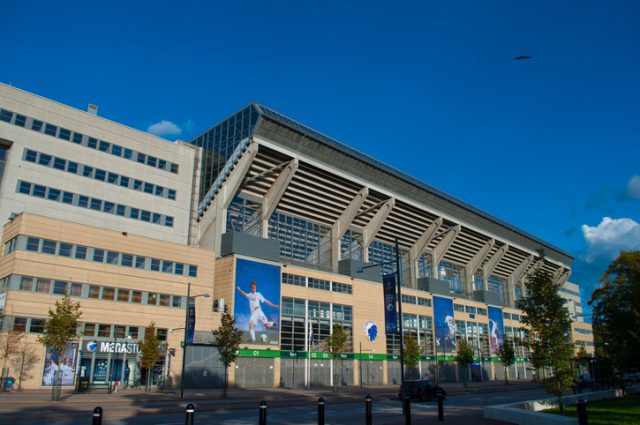
Parken Stadium, generally known as Telia Parken, was built in 1992. Features a retractable roof with a maximum capacity of 38,065 people. It is the largest stadium in Denmark and the national football team’s home. It is built on the location of the previous national stadium.
Parken hosted the Cup Winners’ cup final between Arsenal and Parma in 1994 and the UEFA Cup final in 2000 between Galatasaray and Arsenal. In addition, Parken stadium will host three group matches and a round of 16 games of the UEFA Euro 2020.
UEFA 2020 with Talk Home – Football Stadiums
Wondering how to watch the Euro matches, share the madness with friends, and still follow COVID-19 guidelines? Everyone in the UK and Europe is crazy about their teams, and even a single encounter between them can make things roll for many of us. If you want to share the joy with your friends and family while moving across the continent with every match, you’ve come to the right place.
We, too, are excited for Euro 2020; therefore, we’re offering 50 per cent off on all our best national and international calling plans. So, use Talk Home to savour the best roaming rates if you’re going to Copenhagen or Bucharest to enjoy the league matches. Nevertheless, our national plans can be the best fit if you’re looking forward to enjoying the finals at the Wembley stadium.
Similarly, high data charges while moving across Europe can leave a dent in your wallet, which is why you should consider saving your data.
To save you from any inconvenience, we at Talk Home offer super saver data plans. If you’re moving from city to city with every match, you would love to share the vigour and joy with people on the internet and live stream either on YouTube and Facebook or post moments on Instagram feed.
Talk Home goes everywhere with you without any border limitations. Taking action and passion across destinations, you can share your sentiments with the ones you care about and the ones following you on social media.
We wish you an energetic and joyful football season. Stay safe, happy, and connected with Talk Home by your side.

